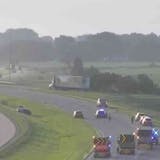Opinion editor's note: Star Tribune Opinion publishes a mix of national and local commentaries online and in print each day. To contribute, click here.
•••
I know that stoning people to death is barbaric. But I never understood just what it entails — the slow, cruel process by which a defenseless human being is degraded and destroyed — until I saw a series of photographs taken by Somali photojournalist Farah Abdi Warsameh, which depict the stoning execution of a man accused of adultery by the insurgent group Hizbul Islam. While some charge that viewing such pictures is voyeuristic, these images made me face the terror, the blood and the sheer cruelty of this practice — one that, astonishingly, has not yet been tossed into the dustbin of history.
Photographic images can bring us close to the experience of suffering — and, in particular, to the physical torment that violence creates — in ways that words do not. What does the destruction of a human being, of a human body — frail and vulnerable (all human bodies are frail and vulnerable) — look like? What can we know of another's suffering? Is such knowledge forbidden — or, alternately, necessary? And if we obtain it, what then?
These are questions that are being raised in the wake of last week's mass shooting of 19 children and two adults in Uvalde, Texas, which has plunged much of the country into an abyss of sorrow, rage and despair. On social media and in the press, some, including the former homeland security chief Jeh Johnson, have suggested that photographs of the slaughtered children, whose faces and bodies were apparently mutilated beyond recognition, be released to the public in hopes of garnering support for gun control legislation.
Johnson called this an "Emmett Till moment," alluding to a photograph of the 14-year-old Black boy who was tortured and murdered by white racists in Mississippi in 1955. His mother had insisted on an open casket: Let the world — make the world — see what her son's tormentors had done. And the world did: The photograph of Till taken by Jet magazine was reproduced throughout the country and abroad and helped invigorate the civil rights movement.
The question of how much violence we should see, and to what end, is almost as old as photography itself. But the question gains urgency in our age of unfiltered immediacy — of the 24-hour news cycle, of Instagram and Twitter, of jihadi beheading videos, of fake news and conspiracy theorists and of repellent sites like BestGore, which revel in sadistic carnage. What responsibilities does the act of seeing entail? Is the viewing of violence an indefensible form of collaboration with it? Is the refusal to view violence an indefensible form of denial?
In the case of Uvalde, a serious case can be made — indeed, I agree with it — that the nation should see exactly how an assault rifle pulverizes the body of a 10-year-old, just as we needed to see (but rarely did) the injuries to our troops in the Iraq and Afghanistan wars. A violent society ought, at the very least, to regard its handiwork, however ugly, whether it be the toll on the men and women who fight in our name, on ordinary crime victims killed or wounded by guns or on children whose right to grow up has been sacrificed to the right to bear arms.



